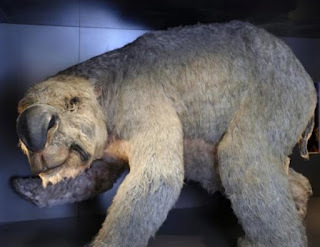REMAINS OF A DIPROTODON FOUND.

In 1924, The Mail (newspaper) reported that Professor WalterHowchin unearthed the bones of a Diprotodon at Gawler. It also reported thatother bones had been found in the bed of the River Torrens, and at LakeCallabonna in the States far north.
In 1936, describing Gawler’sriver system, the Bunyip newspaper referred to a Kaurna people allegory of theMoole Yerke Perre, a large ‘weird antediluvian monster (that) was responsiblefor the permanent marks made by its nose and shins,’ in the riverbeds andbanks. The Bunyip reporter then links this creature to the 1891 discovery of Diprotodonfossils in Gawler.
The Bunyip reported on the original 1891 find of bones,
Scientific Discovery at Gawler South.
REMAINS OF A DIPROTODON FOUND.
A discovery of more than ordinary interest was made at Gawler Southa few days ago by some workmen who were excavating a tank on the property ofMr. Thomas Molan. When they had sunkabout 8 ft. they came upon a deposit of bones. At first, they took very littlenotice, and as they were very crumbly shovelled them out with the clay.
After a time the size of some of the bonesattracted their curiosity, and one of the members of the Gawler GeologicalClass having been communicated with it was thought to be the remains of theextinct Australian marsupial, the diprotodon.
Mr. W. Howchin, F.G.S., the lecturer of the Gawler Geologicaland Mineralogical Class was informed, and came up on Wednesday afternoon. He atonce confirmed the opinion. Bones continued to show themselves right across thetank and to a depth of 11 ft. At the latter depth a portion of the head wasunearthed, and as it was desired to get it out as perfectly as possible it wasdecided to obtain the services of Mr. A. Zielz, of the Adelaide Museum.
That gentleman came up yesterday morning, and completedthe exhumation, although he had to be content to get the head out in pieces. The diprotodon issaid to have lived in the post-Pliocene age — before the age of man and wasabout the size of an elephant. Its head was about 3 ft. in length. Very few remainsof the species have been discovered, and the best skeleton is said to be in possessionof the Adelaide Museum it having been obtained from the Burra district recently.No complete skeleton, however, has yet been found. It is impossible to tell yethow complete the present skeleton is as the bones are so broken, but Mr. Zietzdoes not think it will be as perfect as that obtained from the Burra.
All the bones were carefully packed in caseswith sawdust preparatory to being sent to the Adelaide Museum forreconstruction. Just as they were about to be taken away the owner of the propertyappeared on the scene and declined to allow them to go to Adelaide unless he waspaid £10. As Mr. Zietz could not promise that amount without consulting his Committee,the cases were placed in the hands of Mr. E. Potter, the Chairman of the Gawler GeologicalClass, until a decision is arrived at.
A large number of persons visited thescene of the discovery yesterday. Mr. W. H. Percy, who was working on the property,rendered valuable assistance in getting the remains out, and the contractor, Mr.James Peek offered every facility.
Perhaps, when recollecting in a 1952 issue of TheAdvertiser Ernest L.B. Potter of Croydon, he remembered wrongly that his uncleEdward Potter had discovered the Diprotodon, instead of Professor Howchin. Inan Out Among the People column, it was reported,
ERNEST L. B. Potter (West Croydon) tells me that as a boy of10, about 1890, he remembers a diprotodon skull being found in an excavationfor an underground tank at Gawler South, near Dead Man's Pass on the South Paraand the road to One Tree Hill. His uncle, Edward Potter, a geologist,pronounced it to be a diprotodon.
The skull and bones found in Gawler were identified as thoseof a Diprotodon from the Pleistocene Epoch of Australia. Diprotodon Optatum became extinct about 25,000 years ago and was known to exist while indigenous populations were in thearea. These animals grew up to 3.8 meters long from head to tail and stoodabout 1.7 meters tall at the shoulder. Its closest relations today arethe wombat and the koala.
For more information on the Diprotodon, please visit here: Diprotodon: Not a wombat
Researched and written by Allen Tiller © 2024.
'Prehistoric Times In South Australia', The Mail, (1 March 1924),p. 1.
'Early Gawler And District Nomenclature.', Bunyip, (11 December1936), p. 8.
'Scientific Discovery at Gawler South.', Bunyip, (24 July 1891), p.2.
'OutAmong The People', The Advertiser, (2 September 1952), p. 4.



